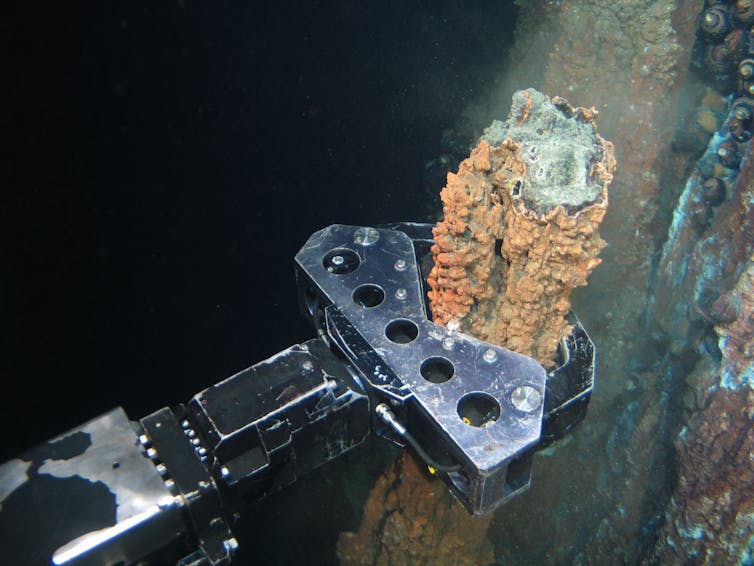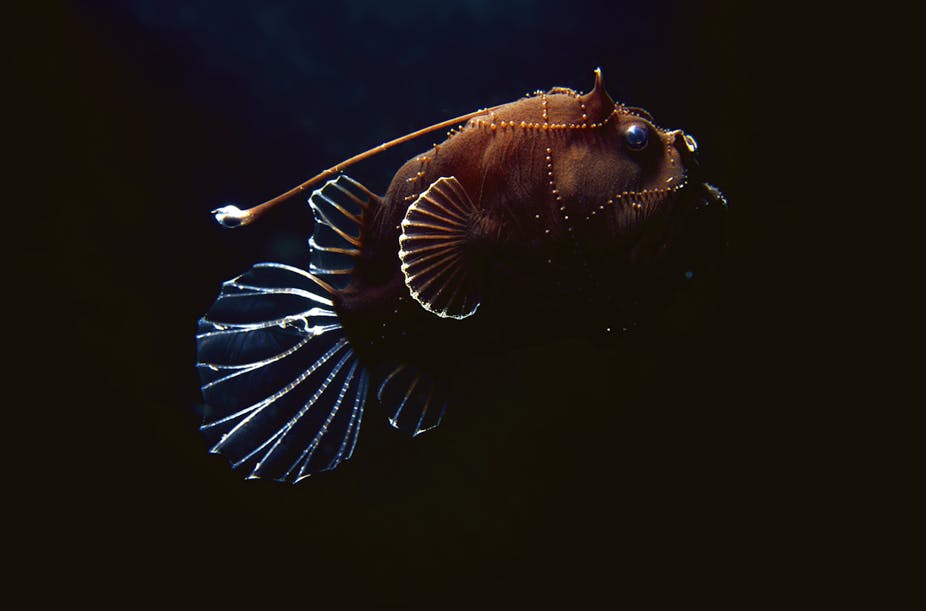With the global population now well over seven billion people there are few remaining parts of the world relatively untouched by human activity. We assess the current state and future prospects of five final frontiers: rainforests, Antarctica, the Arctic, the deep sea and space.
The deep sea is truly the last frontier on our planet. With an average depth of more than 4,000m and falling to almost 11km in the Marianas Trench (put Mt Everest at the bottom of this trench and its tip would be more than 2km below the ocean’s surface). This is an environment that is quite unlike any in human experience, and few have experienced it first hand.
Deep water presents significant challenges to organisms that eke out an existence in its cold, lightless waters under huge atmospheric pressure (pressure at sea level [1 atmosphere] increases by an additional atmosphere of pressure for every 10m of descent).
Most deep sea ecosystems are supported by the “rain” of material from the ocean’s surface. With the exception of an occasional bonanza when a whale carcass settles to the bottom, food resources are scant.
But this environment isn’t a food-depleted, depauperate desert: it supports a surprising diversity of fauna, much of it living within the sediment. Recent estimates indicate that the deep sea supports diversity equivalent to that of soft sediment environments in shallow coastal seas. It is likely diversity accumulates because of very low levels of extinction stemming from the inherent stability of these environments.
Much of the fauna show special adaptations to an environment where food and mates may only be encountered rarely. Many of the fishes are “sit and wait” predators rather than active hunters. Their highly distendable bellies, large mouths and hinged jaws allow them to consume prey virtually as large as they are. Many also possess over-sized recurved teeth; so big, in fact, that they cannot close their mouths. Once captured, prey have little chance of escape.
Some species have overcome the difficulty of finding mates by carrying tiny males of their species with them. The small males attach to females and following the atrophy of their guts become effectively parasitic; little more than bags of sperm with the sole function of fertilising the female’s eggs.

The deep is also home to a unique ecosystem, based not on algal growth fuelled by solar radiation, but the breakdown of complex molecules by microbial organisms. It’s an ecosystem based on chemosynthesis, rather than photosynthesis. Those organisms that don’t feed on these microbial gardens incorporate microbes in their bodies in a symbiotic relationship: some of them get by even though they completely lack guts.
These unique communities are normally found at mid-oceanic ridges where seafloor spreading is laying down new crust and volcanic vents release superheated water, rich in chemical compounds.
The remote nature of these environments, the logistic difficulty and expense of accessing them has slowed but not halted human threats. William Beebe and Otis Barton made a pioneering bathysphere dive to 914m in 1934: the first human excursion into deep water. Now the oil and gas industry are seeking deeper reserves as shallow-water wells run dry.
The challenge of working in such deep environments is underscored by the recent Deepwater Horizon spill, where delays in capping the wellhead sent an estimated 780,000 cubic meters of oil into the Gulf of Mexico.
Commercially valuable metals, including gold and silver, are precipitated from the mineral-rich superheated water associated with mid-oceanic ridges. Although there are moves to exploit these minerals, the cost and logistic difficulties mean it is unlikely to occur on a large scale.
These vent systems have a finite lifetime and their associated fauna disappear when they are no longer active, so an extractive industry could be built around inactive vents, thereby minimising impacts.
Historically, deep-sea fisheries were not exploited; but as near-shore stocks suffered depletion the deep sea has become a target for fishing activities. Conveniently for fishermen, several species also form large spawning aggregations around deepwater seamounts – providing easy targets for fishermen’s trawls.

Deep-sea fish are more vulnerable to exploitation than their shallow water cousins. They are generally long lived, slow growing and may not reach sexual maturity until their late teens. These characteristics mean there is every chance that fish will be caught before they have a chance to reproduce and therefore replace themselves.
To make matters worse, the survival of undersized target species or non-targeted bycatch is virtually zero when they are brought up from great depth, as their swim bladders expand or burst. And trawl nets inflict considerable physical damage on the bottom and its non-targeted inhabitants.
Fortunately the value of deepwater seamounts is now better appreciated and their biological resources protected within Marine Parks.
Scientists have now chronicled the decline of exploited deepwater fish stocks in the North Atlantic. Populations of exploited fishes have declined by an alarming 95% within 25 years, accompanied by dramatic reductions in fish size.
If we apply the criteria of the International Union for the Conservation of Nature, these species would be considered critically endangered.
Though remote, the deep sea will be touched by climate change. The ocean is a sink for human-derived atmospheric carbon dioxide. This is reducing the pH (level of acidity) of the ocean’s surface waters and also affecting the carbonate chemistry of the sea, particularly the deep sea. Below a certain depth, carbonate becomes under-saturated in seawater and this means calcifying (shell-forming) species cannot make their calcium carbonate shells or skeletons.
This saturation horizon will move toward the surface as carbon dioxide levels rise, resulting in the dissolution of carbonate shells and skeletons. Colder water favours dissolution and deepwater corals in the southern ocean are already under threat.
It is sobering that our activities in cities will have profound impacts on what is truly the world’s last frontier. Our actions today will have far-reaching consequences tomorrow.
Next: Space.

